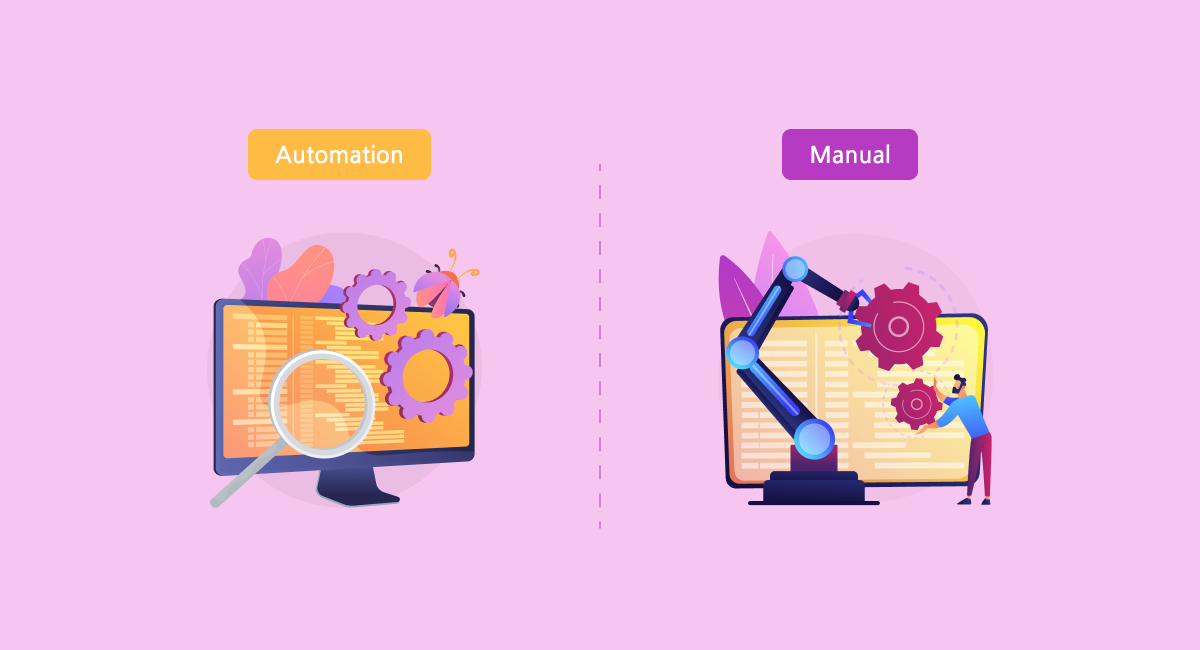Manual Testing Vs Automation Testing: Which One to Choose?

Every software requires to go through the testing procedure so that one can be sure that the output is bug-free and ready to go live. Users will step out of your platform if it fails to provide satisfactory performance. Hence software testing remains the crucial process during the entire software development life cycle. At present, one can acquire two testing approaches – Manual and Automation testing.
Highlights
- 1 Manual Testing Vs Automation Testing: Which One to Choose?
- 1.1 What is Manual Testing?
- 1.2 What is Automation Testing?
- 1.3 Manual Testing Vs Automation Testing: Know the Key Differences
- 1.4 Benefits and Drawbacks of Manual Testing
- 1.5 Benefits and Drawbacks of Automation Testing
- 1.6 Different Sorts of Testing And Their Suitable Test Approaches
- 1.7 Manual Testing Vs Automation Testing: Our Pick
So deciding between Manual testing vs Automation testing can lead to great confusion. Like which will be an appropriate option, the traditional Manual method or the modern Automation method? If you are feeling stuck between these two approaches, here is a quick comparison to check out. In this article, you will get to know the primary difference between Manual and Automation testing, along with their pros and cons that will help along the way. Let’s have a look.
What is Manual Testing?
Manual testing refers to a procedure where a physical entity executes the task by pursuing a written test agenda that consists of several test types and identifies weak points in the software. Manual testers play an important role in ensuring the adequate functionality of the project before the launching period.
Quality Assurance analysts first get familiar with the purpose of the product and prepare a test environment to check whether the end-user’s requirement gets satisfied or not. Under Manual check, each prospect of the test gets marked by analysts. After the procedure, they document each bug or error if found on the software. In considerable cases, they conduct in-depth checking in order to find the cause of the misconception. Since no tools are entangled in Manual testing, this procedure tends to be expensive, sluggish, plus long-drawn-out.
What is Automation Testing?
Automation testing refers to the automatic testing of software using tools. It makes use of test Automation frameworks and toolkits to execute test cases automatically. Where a particular framework is scripted with the ordinances of Automation to test the product. In simple words, we can explain it as a computerized examination that conducts with minimal interference from the human. Moreover, the Automation frameworks are combined with assorted segments like test data references, object attributes, and other modules.
The global Automation test market length suggests that the estimated revenue of 2022 was $24.7 billion, which is forecasted to hit $52.7 billion by the end of 2027, with a 16.4 % CAGR from 2022 to 2027. So it suggests a rapid rise in Automation test strategies.

Manual Testing Vs Automation Testing: Know the Key Differences
Here is a table showing the difference between Manual and Automation testing, which will give a precise idea to pick the specific procedure to examine your next product.
| Manual Testing | Automation Testing |
|---|---|
| Analysts Manually conduct the testing procedure to find blunders in the software. | Tools and technologies have been utilized to check for errors in the product. |
| Human interference is a must. | Eliminates the requirement of human interference. |
| Exploratory testing can be accomplished. | It does not authorize random checking. |
| It consumes more time since it’s executed by a human entity. | The Automation method is way faster compared to a Manual strategy. |
| There is no requirement to have an understanding of coding. | Automation testing demands in-depth knowledge of programming. |
| As the human tendency is to cause errors, human errors can be accrued since it’s done by humans. | It does not include any human errors because the test is done by employing tools. |
| Manual testing does not utilize frameworks. | It makes use of frameworks such as keyword-driven, data-driven, etc. |
| Human observation can be possible when the matter is to look for user-friendliness in software. | Human dealings are not feasible; consequently, machines can not depict a satisfactory user experience in software. |
Benefits and Drawbacks of Manual Testing
Benefits:
- The Manual element is less costly as there is no need to invest in mechanization tools.
- The key difference between Manual and Automation testing relies on receiving accurate feedback, so here Manual approach beings ideal for receiving accurate feedback compared to machinery outputs.
- You will not require to compose codes, no matter if you want to make any small change, which will consume time. Hence changes can be made on the way under the Manual procedure.
Drawbacks:
- There is always room for blunders and errors since it’s accomplished by humans, so the results can not be considered reliable.
- Of course, there is no such thing as recording Manual testing; thus, it can not be beneficial to reuse the Manual strategy.
- Under the Manual procedure, it becomes a bit difficult to execute specific tasks, so it can not go beyond the line corresponding to the mechanization method.
Benefits and Drawbacks of Automation Testing
Benefits:
- Automation stands for the best approach in order to spot more bugs compared to human analysts.
- Since the process executes automatically, therefore, one can get test results extremely faster.
- The Automation test can be documented for future prospects, which allows reusing the same approach to test additional operations.
- The human entity can be tired up, so it can not work continuously, while the tools used in Automation testing can constantly work without feeling exhausted.
- It provides an act of great courage to check on even small particles and beings beneficial to boost productivity.
Drawbacks:
- A machine can not predict the human point of view in a way to get visionary aspects of color contrast, sizes, shapes, fonts, etc.
- You have to count on the hefty project budget since the tools required to operate Automation tests can be costly.
- So far, such Automation tools still lack in many ways, which limits the scope of Automation.
- It works on the pre-set route, meaning that it cannot spot new bugs by crossing the pre-encoded approach.
Different Sorts of Testing And Their Suitable Test Approaches
Usability Testing
This one refers to examining user-centered design. So, the most suitable practice is to go with Manual testing. Manual testing performs to check how an app or software is user-friendly and presents a seamless experience to users. The accurate test type is to form an actual end-user experience instead of a mimicked end-user by a device. So the feedback and intake from a genuine user can be more true-to-life than what is forecasted by the machinery language.
Ad hoc Testing
This one is an informal testing type that requires minimal implementation of business logic to work with. Ad hoc testing is the method of conducting a test on-site, either during the ongoing process or after the software goes live. Ad hoc testing builds on traditional usability tests such as exploratory testing. Consequently, the traditional Manual approach is the most suitable to go for.
Exploratory Testing
With exploratory testing, the intent is to examine distinctive scenarios. Of course, a machine can not go outside of limitations, meaning it is only limited to the things that were introduced. So you will require a living entity for exploratory testing who is well-skilled. And the analyst will make use of their knowledge to assume prospects exceeding the limitations. Consequently, here human interaction will be essential to carry out tasks that machines can not do.
Regression Testing
Regression refers to a repetitive test that helps to assure that the newly incorporated functionality works adequately or not or if it affects other components of features. Simply this kind of testing is executed in order to check if the changes made in new versions of the app have somehow introduced any new bugs that can crash the app. So in such time-consuming tasks, the Automation method can be helpful in getting the reports on time.
Performance Testing
As you can guess from the name, performance testing refers to estimating a system’s response time and how stable it is to handle tasks. Such testing can truly be exhausting to test Manually as it will create a heavy workload on how much time it consumes to load the homepage. Therefore the ideal pick is the Automation method that requires lower human intervention to get results.
Manual Testing Vs Automation Testing: Our Pick
After considering the difference between Manual and Automation testing, we can get to know that both strategies consist of their benefits and limitations. But if we look from the ease of manner, then for sure, Automation testing takes the bait. As it requires a low amount of labor-intensive work and delivers results way faster. It can perform tasks without leaving any room for error. So the accuracy in finding and resolving errors is much more satisfactory analogized to the Manual approach.
Now before making a choice between Manual testing vs Automation testing must count on these factors – complexity of the software, project timeline, available resources, and of course, the budget to get the best-fitted option for your specific project.Hire QA tester from Elluminati and take your software testing to the next level.



